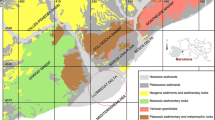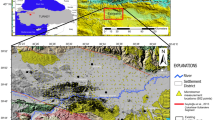Abstract
The city of Ljubljana is located in one of the three areas with the highest seismic hazard in Slovenia, and it is also the most densely populated. Site effects due to Quaternary sediments, which fill the up to 200 m-deep basin, are characteristic of the whole city area, but they can be especially strong in the southern part of Ljubljana, which is built on very soft lacustrine deposits. Existing microzonation studies of the city are inadequate, since there is a lack of borehole, geophysical and earthquake data. The microtremor horizontal-to-vertical spectral ratio (HVSR) method was therefore applied to a 200 m dense grid of free-field measurements over an area of 45 km2 (1,223 measuring points) in order to assess the fundamental frequency of the sediments. The main difficulties in microtremor measurement arose from high levels of traffic and industrial noise, and from underground structures. Experimental conditions which can influence data quality, such as strong wind and water saturation of soil, were analysed. Very clear HVSR peaks were obtained in the entire southern part of the city, whereas in the northern part the site response is in general lower due to lower impedance contrast of gravel with the bedrock. The iso-frequency map of sediments shows a distribution in the range of 0.9–10 Hz. In the southern part of Ljubljana, sediment frequency correlates well with the thickness of soft sediments known from geophysical investigations and sparse drilling. Average amplitude of the HVSR peaks is considerably higher in the southern part (6.7 ± 2.4) than in the northern part (4.0 ± 2.0) of the city, indicating a high impedance contrast of lacustrine sediments with the bedrock. Microtremor measurements were also performed inside 122 buildings of various heights. We focused on important public buildings and selected blocks of flats and houses. To assess the longitudinal and transverse fundamental frequencies of each building, amplitude spectra and the spectral ratio between the upper floor and the basement were analysed for both directions. When one of these frequencies is close to a nearby free-field fundamental frequency, a potential soil-structure resonance is present. This was found in 12 of the measured buildings. Three of them are tall residential buildings (from 10 to 15 floors) with a fundamental frequency of 2–3 Hz, and nine of them are low-rise buildings (from 3 to 5 floors) with a fundamental frequency ranging from 3 to 4.5 Hz. Using the relationship between fundamental frequency and height, the typical height of buildings that might cause soil-structure resonance can be estimated at a given sediment frequency obtained from free-field measurements.
Similar content being viewed by others
References
Bard PY (1999) Microtremor measurements: a tool for site effect estimation?. In: Irikura K, Kudo K, Okada H, Sasatami T (eds) The effects of surface geology on seismic motion. Balkema, Rotterdam, pp 1251–1279
Bonnefoy-Claudet S, Cornou C, Bard PY, Cotton F, Moczo P, Kristek J, Fäh D (2006) H/V ratio: a tool for site effects evaluation. Results from 1-D noise simulations. Geophys J Int 167: 827–837. doi:10.1111/j.1365-246X.2006.03154.x
CEN (2004) Eurocode 8, design of structures for earthquake resistance—part 1: general rules, seismic actions and rules for buildings. European Committee for Standardization, Brussels
Chatelain JL, Guillier B, Cara F, Duval AM, Atakan K, Bard PY (2008) Evaluation of the influence of experimental conditions on H/V results from ambient noise recordings. Bull Earthq Eng 6(1): 33–74. doi:10.1007/s10518-007-9040-7
Cranswick E, Özel O, Meremonte M, Erdik M, Safak E, Mueller C, Overturf D, Frankel A (1999) Earthquake damage, site response, and building response in Avcilar, west of Istanbul, Turkey. Proc of ITU-IAHS int conf on the Kocaeli earthquake, Istanbul, pp 193–204
Fäh D, Kind F, Giardini D (2001) A theoretical investigation of average H/V ratios. Geophys J Int 145: 535–549. doi:10.1046/j.0956-540x.2001.01406.x
Gallipoli MR, Mucciarelli M, Castro RR, Monachesi G, Contri P (2004a) Structure, soil-structure response and effects of damage based on observations of horizontal-to-vertical spectral ratios of microtremors. Soil Dyn Earthq Eng 24: 487–495. doi:10.1016/j.soildyn.2003.11.009
Gallipoli MR, Mucciarelli M, Eeri M, Gallicchio S, Tropeano M, Lizza C (2004b) Horizontal to vertical spectral ratio (HVSR) measurements in the area damaged by the 2002 Molise, Italy, earthquake. Earthq Spectra 20(1): 81–93. doi:10.1193/1.1766306
Gosar A (2007) Microtremor HVSR study for assessing site effects in the Bovec basin (NW Slovenia) related to 1998 Mw5.6 and 2004 Mw5.2 earthquakes. Eng Geol 91: 178–193. doi:10.1016/j.enggeo.2007.01.008
Gosar A, Lenart A (2009) Mapping the thickness of sediments using microtremors in the Ljubljana Moor basin (Slovenia). Bull Earthq Eng (in press)
Gosar A, Martinec M (2009) Microtremor HVSR study of site effects in the Ilirska Bistrica town area (S Slovenia). J Earthq Eng 13: 50–67
Gosar A, Živčić M (1998) The effects of local geology on the ground motion at the southern rim of Ljubljana. Potresi v letu 1997: 59–66
Grad K, Ferjančič L (1974) Basic geological map of Yugoslavia 1:100.000—sheet Kranj. Geological Survey of Slovenia, Ljubljana
Lapajne J (1970) Seismic microzonation of Ljubljana—geophysical investigations. Geological Survey of Slovenia, Ljubljana
Lapajne J, Šket-Motnikar B, Zupančič P (2001) Design ground acceleration map of Slovenia. Potresi v letu 1999: 40–49
Medvedev SV (1965) Inženjerska seizmologija. Gradjevinska knjiga, Belgrade
Mencej Z (1989) The gravel fill beneath the lacustrine sediments of the Ljubljansko barje. Geologija 31–32: 517–553
Micromed (2005) Tromino user manual. Micromed, Treviso
Mucciarelli M, Gallipoli MR (2001) A critical review of 10 years of microtremor HVSR technique. Boll Geof Teor Appl 42: 255–266
Mucciarelli M, Monachesi G (1998) A quick survey of local amplifications and their correlation with damage observed during the Umbro-Marchesan (Italy) earthquake of September 26, 1997. J Earthq Eng 2(2): 325–337. doi:10.1142/S1363246998000150
Mucciarelli M, Contri P, Monachesi G, Calvano G, Gallipoli MR (2001) An empirical method to assess the seismic vulnerability of existing buildings using the HVSR technique. Pure Appl Geophys 158: 2635–2647. doi:10.1007/PL00001189
Mucciarelli M, Gallipoli MR, Di Giacomo D, Di Nota F, Nino E (2005) The influence of wind on measurements of seismic noise. Geophys J Int 161: 303–308. doi:10.1111/j.1365-246X.2004.02561.x
Mucciarelli M, Gallipoli MR, Sket-Motnikar B, Zupancic P, Gosar A, Prevolnik S, Herak M, Stipčević J, Herak D, Milutinovic Z, Olumceva T (2009) Empirical estimates of dynamic parameters on a large set of European buildings. Bull Earthq Eng (in press).
Nakamura Y (2000) Clear identification of fundamental idea of Nakamura’s technique and its applications. 12WCEE, Auckland
Natale M, Nunziata C (2004) Spectral amplification effects at Selllano, Central Italy, for the 1997-98 Umbria seismic sequence. Nat Hazards 33: 365–378. doi:10.1023/B:NHAZ.0000048463.15620.86
Panou AA, Theodulidis N, Hatzidimitriou P, Stylianidis K, Papazachos CB (2005) Ambient noise horizontal-to-vertical spectral ratio for assessing site effects estimation and correlation with seismic damage distribution in urban environment: the case of city of Thessaloniki (Northern Greece). Soil Dyn Earthq Eng 25(4): 261–274
Parolai S, Galiana-Merino JJ (2006) Effects of transient seismic noise on estimates of H/V spectral ratios. Bull Seism Soc Am 96(1): 228–236
Parolai S, Fäcke A, Richwalski S M, Stempniewski L (2005) Assessing the vibrational frequencies of the holweide hospital in the city of Cologne (Germany) by means of ambient seismic noise analysis and FE modelling. Nat Hazards 34: 217–230
Premru U (1982) Basic geological map of Yugoslavia 1:100.000—sheet Ljubljana. Geological Survey of Slovenia, Ljubljana
Ribarič V (1987) Seismological map of Slovenia for 500 years return period. Seismological survey of Slovenia, Ljubljana
Ribarič V (1994) Potresi v Sloveniji. Slovenska matica, Ljubljana
SESAME (2004) Guidelines for the implementation of the H/V spectral ratio technique on ambient vibrations: measurements, processing and interpretation. http://sesame-fp5.obs.ujf-grenoble.fr/Delivrables/Del-D23HV_User_Guidelines.pdf. Accessed 15 Mar 2009
SIST EN 1998-1:2005/oA101, (2005) Eurocode 8, design of structures for earthquake resistance—part 1: general rules, seismic actions and rules for buildings, national Annex. Slovenian institute for standardization, Ljubljana
SPSS (1999) SPSS (Statistical package for social sciences) base 9.0 user’s guide. SPSS Inc, Chicago
Suess FE (1896) Das Erdbeben von Laibach am 14 April 1895. Jahrb K K Geol Reich 46(3-4): 412–890
Yuen KV, Beck JL, Katafygiotis LS (2002) Probabilistic approach for modal identification using non-stationary noisy response measurements only. Earthq Eng Struct Dyn 31(4): 1007–1023
Vidrih R, Godec M, Lapajne J (1991) Potresna ogroženost Slovenije. Seismological Survey of Slovenia, Ljubljana
Zupančič P, Šket-Motnikar B, Gosar A, Prosen T (2004) Seismic microzonation map of the municipality of Ljubljana. Potresi v letu 2002: 32–54
Author information
Authors and Affiliations
Corresponding author
Rights and permissions
About this article
Cite this article
Gosar, A., Rošer, J., Šket Motnikar, B. et al. Microtremor study of site effects and soil-structure resonance in the city of Ljubljana (central Slovenia). Bull Earthquake Eng 8, 571–592 (2010). https://doi.org/10.1007/s10518-009-9113-x
Received:
Accepted:
Published:
Issue Date:
DOI: https://doi.org/10.1007/s10518-009-9113-x




